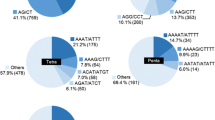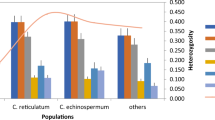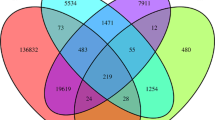Abstract
Codonopsis lanceolata is an herbaceous perennial plant predominantly cultivated in East Asia and used for medicinal purposes. However, genetic information of C. lanceolata is lacking. Therefore, we sequenced genomic DNA using next-generation sequencing (NGS) and searched for simple sequence repeats (SSRs) to develop molecular markers in C. lanceolata. A total of 250,455 SSRs were identified, and di-nucleotides and tri-nucleotides accounted for the majority of all the SSRs. Among these SSRs, we designed 26,334 primer sets from di- to octa-nucleotide motifs. We used an in silico approach to investigate 2626 SSRs (tri- to penta-nucleotide motifs) and found 573 SSRs showing polymorphism. Of the 573 SSRs showing polymorphism in silico, we randomly selected 39 SSRs and verified polymorphism in 16 C. lanceolata accessions. The number of alleles ranged from 2 to 13, and the mean polymorphic information content value was 0.54. Therefore, we successfully designed 39 SSR markers for use in breeding and genetic studies of C. lanceolata.
Similar content being viewed by others
Data availability
Sequencing reads have been deposited in the National Agricultural Biotechnology Information Center (NABIC) Sequence Read Archive (BioProject ID: NN-7251, NN-7252, NN-7253, NN-7254, NN-7255, and NN-7256). Primer sequences have been deposited in the National Center for Biotechnology Information’s GenBank database; accession numbers are listed in Table 3.
References
Altschul SF, Gish W, Miller W, Myers EW, Lipman DJ (1990) Basic local alignment search tool. J Mol Biol 215:403–410
Bolger AM, Lohse M, Usadel B (2014) Trimmomatic: a flexible trimmer for Illumina sequence data. Bioinf 30:2114–2120
Botstein D, White RL, Skolnick M, Davis RW (1980) Construction of a genetic linkage map in man using restriction fragment length polymorphisms. Am J Hum Genet 32:314–331
Celik I, Gultekin V, Allmer J, Doganlar S, Frary A (2014) Development of genomic simple sequence repeat markers in opium poppy by next-generation sequencing. Mol Breed 34:323–334
Edwards KJ, Barker JH, Daly A, Jones C, Karp A (1996) Microsatellite libraries enriched for several microsatellite sequences in plants. Biotech 20:758–760
Eujayl I, Sledge MK, Wang L, May GD, Chekhovskiy K, Zwonitzer JC, Mian MAR (2004) Medicago truncatula EST-SSRs reveal cross-species genetic markers for Medicago spp. Theor Appl Genet 108:414–422
He JY, Ma N, Zhu S, Komatsu K, Li ZY, Fu WM (2015) The genus Codonopsis (Campanulaceae): a review of phytochemistry, bioactivity and quality control. J Nat Med 69:1–21
Holt RA, Jones SJ (2008) The new paradigm of flow cell sequencing. Genome Res 18:839–846
Hosseinzadeh-Colagar A, Haghighatnia MJ, Amiri Z, Mohadjerani M, Tafrihi M (2016) Microsatellite (SSR) amplification by PCR usually led to polymorphic bands: Evidence which shows replication slippage occurs in extend or nascent DNA strands. Mol Bio Res Commun 5:167–174
Howlader J, Hong Y, Natarajan S, Sumi KR, Kim HT, Park JI, Nou IS (2020) Development of powdery mildew race 5-specific SNP markers in Cucumis melo L. using whole-genome resequencing. Hortic Environ Biotechnol 61:347–357
Iniguez-Luy FL, Voort AV, Osborn TC (2008) Development of a set of public SSR markers derived from genomic sequence of a rapid cycling Brassica oleracea L. genotype. Theor Appl Genet 117:977–985
Ishida S, Okasaka M, Ramos F, Kashiwada Y, Takaishi Y, Kodzhimatov OK, Ashurmetov O (2008) New alkaloid from the aerial parts of Codonopsis clematidea. J Nat Med 62:236–238
Jun TH, Michel AP, Mian MR (2011) Development of soybean aphid genomic SSR markers using next generation sequencing. Genome 54:360–367
Jung SW, Han AJ, Hong HJ, Choung MG, Kim KS, Park SH (2006) α-glucosidase inhibitors from the roots of Codonopsis lanceolata Trautv. Agric Chem Biotechnol 49:162–164
Kim HJ, Lee JN, Cho KS, Won HS, Suh JT (2019) Genetic diversity and population structure analysis of Ever-bearing and June-bearing strawberry cultivars using SSR markers. Hortic Sci Technol 37:108–118
Kim S, Jeong JH, Chung H, Kim JH, Gil J, Yoo J, Um Y, Kim OT, Kim TD, Kim YY, Lee DH et al (2016) Simple sequence repeat marker development from Codonopsis lanceolata and genetic relation analysis. J Plant Biotechnol 43:181–188
Kölliker R, Jones ES, Drayton MC, Dupal MP, Forster JW (2001) Development and characterisation of simple sequence repeat (SSR) markers for white clover (Trifolium repens L.). Theor Appl Genet 102:416–424
Komoto N, Ichikawa M, Ohta S, Nakano D, Nishihama T, Ushijima M, Kodera Y, Hayama M, Shirota O, Sekita S et al (2010) Murine metabolism and absorption of lancemaside A, an active compound in the roots of Codonopsis lanceolata. J Nat Med 64:321–329
Lee KT, Choi J, Jung WT, Nam JH, Jung HJ, Park HJ (2002) Structure of a new echinocystic acid bisdesmoside isolated from Codonopsis lanceolata roots and the cytotoxic activity of prosapogenins. J Agric Food Chem 50:4190–4193
Li Z, Liu X, Wang X, Fan B, Wang X, Zhao G (2013) Isolation and characterization of novel microsatellite markers in Codonopsis tangshen (Campanulaceae). Conserv Genet Res 5:393–395
Li ZH, Wen HY, Chen J, Wu GL, Wang YJ (2009) Development of 10 polymorphic microsatellite loci primers for Codonopsis pilosula Nannf. (Campanulaceae). Conserv Genet 10:747–749
Liu K, Muse SV (2005) PowerMarker: an integrated analysis environment for genetic marker analysis. Bioinf 21:2128–2129
Luo R, Liu B, Xie Y, Li Z, Huang W, Yuan J, He G, Chen Y, Pan Q, Liu Y et al (2012) SOAPdenovo2: an empirically improved memory-efficient short-read de novo assembler. GigaSci 1:18
Nguyen TK, Ha STT, Lim JH (2020) Analysis of chrysanthemum genetic diversity by genotyping-by-sequencing. Hortic Environ Biotechnol 61:903–913
Park G, Kim J, Jin B, Yang HB, Park SW, Kang SC, Chung SM, Park Y (2018) Genome-wide sequence variation in watermelon inbred lines and its implication for marker-assisted breeding. Hortic Sci Technol 36:280–291
Park JS, Park JH, Kim SJ, Park YD (2020) Genome analysis of tissue culture-derived variations in regenerated Brassica rapa ssp. pekinensis plants using next-generation sequencing. Hortic Environ Biotechnol 61:549–558
Rafalski JA, Vogel JM, Morgante M, Powell W, Andre C, Tingey SV (1996) Generating and using DNA markers in plants. In Non-mammalian genomic analysis: a practical guide. Academic Press, San Diego, pp 75-134
Rozen S, Skaletsky H (2000) Primer3 on the WWW for general users and for biologist programmers. Methods Mol Biol 132:365–386
Shinde D, Lai YL, Sun FZ, Arnheim N (2003) Taq DNA polymerase slippage mutation rates measured by PCR and quasi-likelihood analysis: (CA/GT)(n) and (A/T)(n) microsatellites. Nucleic Acids Res 31:974–980
Squirrell J, Hollingsworth PM, Woodhead M, Russell J, Lowe AJ, Gibby M, Powell W (2003) How much effort is required to isolate nuclear microsatellites from plants? Mol Ecol 12:1339–1348
Stanke M, Steinkamp R, Waack S, Morgenstern B (2004) AUGUSTUS: a web server for gene finding in eukaryotes. Nucleic Acids Res 32(Web server):W309–W312
Taheri S, Lee Abdullah T, Yusop MR, Hanafi MM, Sahebi M, Azizi P, Shamshiri RR (2018) Mining and development of novel SSR markers using next generation sequencing (NGS) data in plants. Mol 23:399
Ushijima M, Komoto N, Sugizono Y, Mizuno I, Sumihiro M, Ichikawa M, Sekita S (2008) Triterpene glycosides from the roots of Codonopsis lanceolata. Chem Pharm Bull 56:308–314
Van Oosterhout C, Hutchinson WF, Wills DP, Shipley P (2004) MICRO-CHECKER: software for identifying and correcting genotyping errors in microsatellite data. Mol Ecol Notes 4:535–538
Yang T, Fang L, Zhang X, Hu J, Bao S, Hao J, Li L, He Y, Jiang J, Wang F et al (2015) High-throughput development of SSR markers from pea (Pisum sativum L) based on next generation sequencing of a purified chinese commercial variety. PLoS ONE 10:e0139775
Yoo GE, Lee U (1989) A taxonomic study of the genus Codonopsis in Korea. Kor J Plant Tax 19:81–102
Zhu H, Senalik D, McCown BH, Zeldin EL, Speers J, Hyman J, Bassil N, Hummer K, Simon PW, Zalapa JE (2012) Mining and validation of pyrosequenced simple sequence repeats (SSRs) from American cranberry (Vaccinium macrocarpon Ait.). Theor Appl Genet 124:87–96
Acknowledgements
This work was carried out with the support of "Cooperative Research Program for Agriculture Science & Technology Development (Project No. PJ01588301)" Rural Development Administration, Republic of Korea.
Author information
Authors and Affiliations
Contributions
SCK, OTK, S-CK, HBK, YL: conceived and designed the experiments, SK, JG, YU: performed the experiments, NJ, CPH, S-GP, YL: analyzed the data, DHL, B-HJ: contributed reagents/materials/analysis tools, SK, NJ, YL: wrote the paper.
Corresponding author
Ethics declarations
Conflicts of interest
The authors declare no conflict of interest. The founding sponsors had no role in the design of the study; in the collection, analyses, or interpretation of data; in the writing of the manuscript, or in the decision to publish the results.
Sample availability
Samples of this research are available from the authors.
Additional information
Communicated by Inhwa Yeam.
Publisher's Note
Springer Nature remains neutral with regard to jurisdictional claims in published maps and institutional affiliations.
Supplementary Information
Below is the link to the electronic supplementary material.
Rights and permissions
About this article
Cite this article
Kim, S., Jo, N., Gil, J. et al. Development of genome-wide simple sequence repeat markers in Codonopsis lanceolata using next-generation sequencing. Hortic. Environ. Biotechnol. 62, 985–993 (2021). https://doi.org/10.1007/s13580-021-00389-0
Received:
Revised:
Accepted:
Published:
Issue Date:
DOI: https://doi.org/10.1007/s13580-021-00389-0




